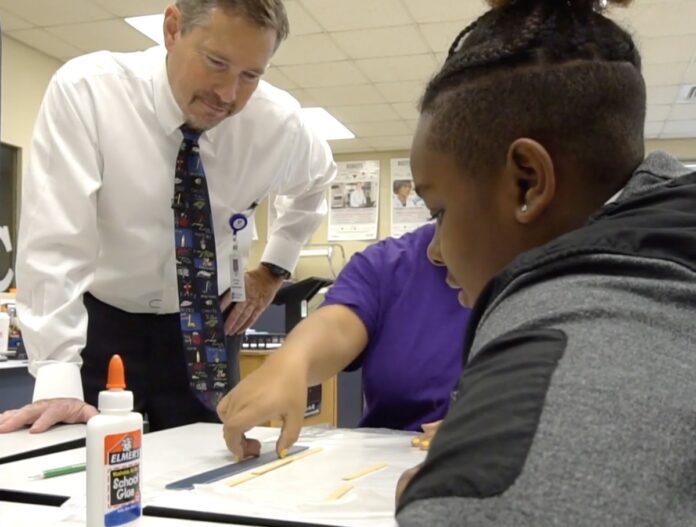Many superintendents share similar challenges in remaining student-driven, but only a few get the chance to lead two districts through a merger. Superintendent Marcella Shaw now helms the Barnwell County Consolidated School District, which was formed with the goal of emphasizing the best interests of students without getting bogged down in, for instance, worrying who would become the superintendent, Shaw says.

Shaw, who is also South Carolina’s 2023 Superintendent of the Year, was leading Barnwell 29 School District in Williston when she began working to consolidate with leaders of a neighboring system, Barnwell County School District 19. State law required the districts to be combined because enrollment in each had dropped below 1,500 students.
Administrators of the two districts held team-building activities and gathered feedback from stakeholders throughout both districts. “I have a love for this community and I have a love for these scholars,” Shaw says. “I did not want to walk away in the midst of change and I knew that either myself or the other superintendent would be a stabilizing force.”
Shaw’s prioritization of students’ best interests is an example of how District Administration‘s latest round of superintendents to watch are remaining student-driven as they drive their districts forward.
Student-driven consolidation
Students in the Barnwell County Consolidated School District can now choose from a wider range of course offerings, such as a theater class that is shared between the two high schools. The new district has partnered with the local technical college to increase dual-enrollment classes and has given students in the former Barnwell County School District 19 access to the gifted and band programs. The new district has also dedicated a bus driver to transport students back and forth so they can take classes that are only offered at one of the district’s high schools.
To keep students engaged and involved, she hopes the merger allows her to reinstitute programs such as soccer and start new ones, like wrestling. She’s also working to launch an academy for gifted students. “We want to be recognized nationally as a rural school district that’s making a difference,” she adds. “If you have a diploma from Barnwell, I want that to be recognizable across the nation as producing scholars who are creative, critical thinkers who can be great leaders. If you have a diploma from Barnwell, I want that to be worth gold.”

Shaw has set goals in several priority areas for her district: academic excellence, safety, fiscal responsibility, community and operating efficiency. For instance, a recent safety review revealed that not all custodians had walkie-talkies to communicate in emergencies and that trees around some schools had to be trimmed to clear views for surveillance cameras. Safety also means making all staff and students feel valued, which includes fostering an inclusive climate and issuing retention bonuses to all employees.
“If we make the district a safe space where people feel honored—where people feel like they have a voice and that they are contributing—that is a big retention strategy,” says Shaw. “We are working very hard to create conditions so our folks want to come to work.”
Barnwell schools that were identified as needing technical assistance from the state when Shaw become superintendent in 2018 have been making gains. With continuous improvement in mind, Shaw is now using state funds to hire a parent-student engagement specialist to convince families who left school during COVID to return. She also launched a parent university program that provides 18 weeks of training and culminates with a traditional-style graduation. “Some of those parents hadn’t graduated from high school and it was their first experience wearing a cap and grown,” Shaw points out.
Shaw and her team are using COVID relief funding to hire content specialists to provide academic interventions to bridge learning gaps. Along with that recovery initiative, there has been an emphasis on college prep in middle school and building a state-of-the-art STEM lab. “Anything we can do to keep scholars involved and with us, that’s what we’re going to do,” Shaw says.
Career and college momentum
One of the “crown jewels” in North Carolina’s Pitt County Schools is its “Advanced Teaching Roles” program, which was launched in 2018, Superintendent Ethan Lenker says. It’s a multi-year process that capitalizes on the expertise of teachers to give them instructional leadership opportunities as well as a bump up in pay. The initiative has two levels—facilitating teachers and cooperating teachers.
More from DA: How superintendents’ student advisory councils are boosting school morale
Facilitating teachers lead a team of their colleagues in a specific subject, such as fifth-grade math, to oversee lesson planning and other key tasks. These teachers are those who have produced high test scores, formed strong relationships with their fellow educators and participated in extensive professional development. “It’s like a super professional learning academy,” Lenker says. “It has made a vast difference within our schools as far as quality of instruction.”
Cooperating teachers earn extra pay to do extra work—such as more comprehensive lesson planning—outside of their regular classroom duties. These teachers are essentially taking on a growth role, Lenker explains. In just the second year of “Advanced Teaching Roles,” students showed tremendous growth, which continued at a higher rate the following year. COVID has since disrupted some of that progress.
Pitt County is also using federal grants to provide coaching to principals and assistant principals. Still, the biggest struggle has been finding qualified teachers and other personnel, including principals, custodians, bus drivers, and teaching assistants. “For years, we’d advertise for certain positions and have 20 people apply,” Superintendent Ethan Lenker says. “Now, we only get one or two.”
On the instructional side, the district has created two early-college high schools in recent years while leaders have prioritized creating more opportunities for students. Its partnership with Pitt County Community College provides students with alternatives beyond the early-college high school, such as dual enrollment courses that students take on the college’s campus. One result is that about half of Pitt County’s seniors are graduating high school with an associate’s degree.
Pitt County also created its virtual academy several years before COVID to rectify an opportunity gap that blocked students in the district’s smaller high schools from having access to classes offered in the bigger schools. “It had been challenging to grow but the pandemic helped the program take off because we had teachers who really knew what they were doing with virtual instruction,” Lenker says.
Virtual teachers are now delivering live instruction to small groups of students from multiple schools but they also visit individual buildings in person at least one day a week. Pitt’s leadership team has also been growing its technical academy by, for one, beefing up transportation so more students have access to the slate of programs that have grown from four to eight, including welding and computer information management.
“It’s all about our students having the ability to get endorsements or certifications so they can get moving with careers or college,” Lenker explains. “Our big goal is to make sure all students can get involved somewhere within their high school or at the community college.”
Staying grounded and student-driven
Superintendent Fred Rundle says that meetings with his student advisory council are one of his favorite activities in the Seattle-area Mercer Island School District. This year, the students in the fifth to 12th grades who serve on the advisory council are focused on taking action in the “four B’s”: Belonging, belief, barriers and broadcasting. “One of the things we heard last year was the group likes coming together to share ideas but they also wanted to do something,” Rundle explains. “So, we set out to explore these four B’s that are integral to our success. Without them, we won’t be able to attend to students as their whole selves.”
FETC 2023
The Future of Education Technology® Conference takes place live and in-person Jan. 23-26, 2023, in New Orleans. Register now!
The advisory council helps Rundle “stay grounded in students” as administrators often risk losing connection with classrooms when they move into the central office. The feedback he gets directly from students also gives him more credibility when he relays their interests to educators, school board members, the PTA and other stakeholders with whom he meets.
“These are opportunities for students to pull up a chair and join in as meaningful participants, not just as passive observers,” he says. “The council gives me windows into our schools that I may not otherwise see and then have conversations with principals, teachers, bus drivers, nurses and paraeducators.”
That collective student voice has lately been expressing a lack of confidence that their feedback will actually bring about change. “If you’re going to find truly representative voices from around your district, be ready for all aspects of that feedback,” Rundle advises other administrators who may be considering launching an advisory council. “Students are very honest. If you, as a leader, are not ready to listen and then act, it’s probably not something that’s worth anyone’s time.”
Some principals in the district are now launching their own building-based advisory councils. “What we always need to remember is that schools were not built for adults; they were built for students and they are community spaces for students,” Rundle says. “We are here to facilitate their learning in preparation for life beyond our schools.”
But we don’t have to take only Rundle’s word about the impact the councils are having on students’ sense of empowerment. “I now know I have a say in making change,” says Ava Zhang, a sophomore member of the advisory council. “We’re talking about tangible goals. We’re talking about belonging and changing the curriculum for subjects like anti-bullying so people are more accepting.”
Diversity is a priority for the council’s students, who work to recruit new members that are not already in some type of school leadership position. “It’s not just the loudest students, it’s also the quieter ones,” says senior Andrew Howison, who is also a student representative to the Mercer Island school board. “It’s students who represent different cultures and identities because it’s a committee that has access to the superintendent and a great amount of ability to make change.”










